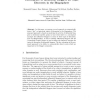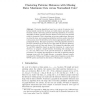1277 search results - page 1 / 256 » The Google Similarity Distance |
CORR
2004
Springer
13 years 9 months ago
2004
Springer
Words and phrases acquire meaning from the way they are used in society, from their relative semantics to other words and phrases. For computers the equivalent of `society' is...
WWW
2007
ACM
14 years 10 months ago
2007
ACM
Discovering mappings between concept hierarchies is widely regarded as one of the hardest and most urgent problems facing the Semantic Web. The problem is even harder in domains w...
CORR
2006
Springer
13 years 9 months ago
2006
Springer
We survey the emerging area of compression-based, parameter-free, similarity distance measures useful in data-mining, pattern recognition, learning and automatic semantics extracti...
SBP
2010
Springer
13 years 7 months ago
2010
Springer
In this paper, we propose a novel approach to automatically detect "hot" or important topics of discussion in the blogosphere. The proposed approach is based on analyzing...
DIS
2006
Springer
14 years 1 months ago
2006
Springer
Abstract. Clustering algorithms based on a matrix of pairwise similarities (kernel matrix) for the data are widely known and used, a particularly popular class being spectral clust...


